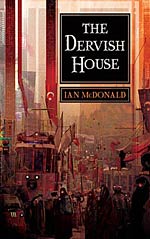
![]() charlesdee
charlesdee
3/2/2014
![]()
Istanbul in 2027. Migrating cranes ride the currents of a heat wave that makes the traffic jams and pollution more unbearable than usual. There are terrorist attacks and fortunes to be made in the esoteric worlds of high finance and the burgeoning nanotechnology industry. Genius helps in the nano world just as a willingness to break the law helps one in finance. McDonald creates characters to fit both categories.
Swarm bots, tiny nano constructions that can coalesce into a spider, a monkey, a snake, or most any other shape, dart through the city skies and provide an apt image for McDonald's narrative devices. He disperses a half dozen or so characters across the city from the rundown neighborhood where they live in the same dervish house, the last such wooden structure to survive both fire and the developer's wrecking ball. We follow them into the skyscrapers that house investment banks, the marketplaces where one can still buy anything from fake antiquities to psychic advice, the coffee shops where aging Greek immigrants spend their days grousing and observing, mosques whose architecture may spell the final name of God, and underground water systems that teem with djinn and the spirits of long-deceased Sufi saints. One character leads his small band of financial wizards in an illegal scheme that will make them multi-millionaires. Another group has developed the next big thing in nanotech that will produce change so profound it might be considered an evolutionary development. After surviving a bus bomb, one young man sees his city filled with djinn. A nine-year-old computer whiz plays Boy Detective and may be the only person that can stop a massive terrorist attack. An art dealer gathers clues on the whereabouts of The Mellified Man, a Sufi saint whose body is preserved in honey. If this all seems frantic, it is. But one plotline provides a quality of melancholic calm. A Greek immigrant who feels old and useless in his late sixties has a chance to reunite with the woman he loved forty-seven years ago.
McDonald pretends the reader is conversant on the details of Turkish history, the geography of Istanbul, both Islamic theology and folklore, and the workings of financial markets. You can spend a lot of time on Google Maps and Wikipedia, but I recommend going along for the ride. The story may seem impossibly complex at times, but your sense that McDonald is a master storyteller who is winding his way to a satisfying conclusion will not be disappointed.
http://www.potatoweather.blogspot.com